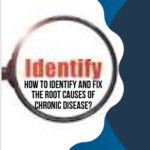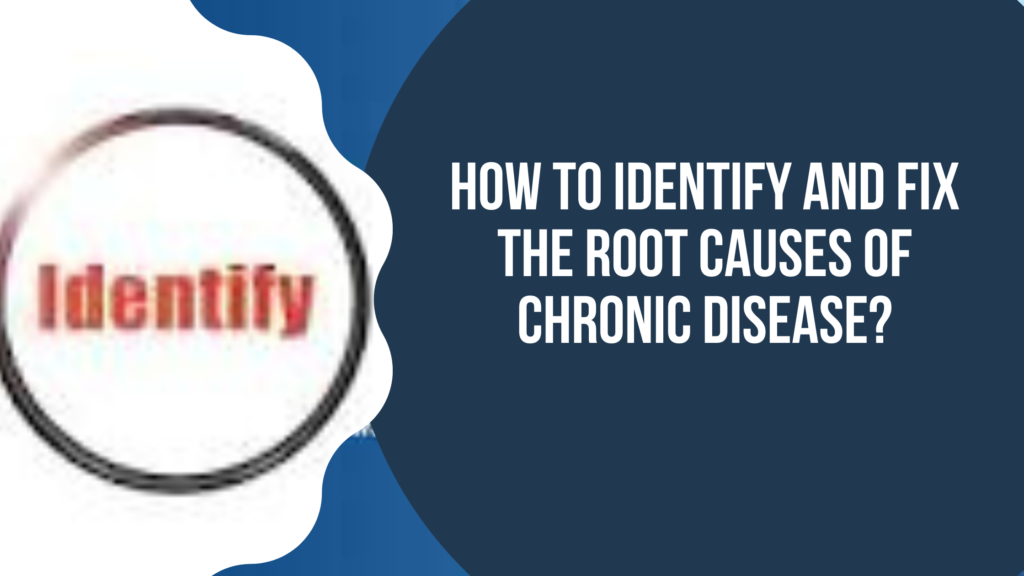How to Identify and Fix the Root Causes of Chronic Disease?
Root Cause Analysis for Chronic Disease: A Step-by-Step Guide
Introduction
Learn about Root Cause Analysis for Chronic Disease: A Step-by-Step Guide, how to identify and fix the root causes of chronic disease with this comprehensive guide. Covers the latest research on chronic disease prevention and management. What you will learn here:
- chronic disease root cause analysis
- identify root cause of chronic disease
- fix root cause of chronic disease
- chronic disease prevention
- chronic disease management and
- methods for root cause analysis of chronic diseases
Methodology

Conventional medicine says that the underlying cause of chronic diseases is not known. They have not discussed anything on this topic. Instead of discussing the underlying cause, they propose several risk factors as the cause of chronic diseases.
5 Why method is a standard procedure for root cause analysis of any problems in any sector and is very useful
Root Cause Analysis for Chronic Disease using 5 why method
let me take the example of type 2 diabetes. The intent is to reach at the root cause of diabetes using the 5 why method. The simplest method that can be tried. Millions of people suffer from type 2 diabetes. The step wise method involves asking the question at least 5 times.
RCA Process 5 why method: RCA for Type 2 diabetes
1.0) Why did he get diabetes?
Because his blood sugar levels are high
2.0) Why his blood sugar levels are high?
Because he eats carbohydrates
3.0) Why does he eats carbohydrates?
To get energy
4.0) Why he needs energy?
To move our bodies: We use energy to move our muscles, which allows us to walk, run, jump, and do other activities.
5.0) Why do we move our bodies?
To carry out our day to day activities.
Result: The result of this 5 why analysis is that we move our bodies in order to carry out all our activities, for which we need energy and to get energy we eat carbohydrates and that leads to diabetes. in summary, a wrong result results.
Using this method we cannot identify the root cause. we need to dive further deep into the subject or the problem. The PLMI blog: Challenges for Root Cause Analysis in Acute and Chronic Illnesses discusses says that It’s an understatement to say that detecting the underlying root cause of human illness is very challenging.
——————————————————————————————————————————
Why do we get high cholesterol? Cannot answer because we are trying to find the answer for this.
Why do we get cancer? ——————– same…………………………………………..
Why do we get heart disease?
Root cause analysis of chronic disease using the question Why?
| Sr no | Chronic disease | Reason |
| 1
2 3
4 5
6 |
Why do we get a heart attack?
Why your arteries are blocked? Why plaque is deposited in arteries? Why LDL levels are high? Why saturated fats should increase LDL levels. Why excess LDL levels should damage the arteries and not the veins and other parts of the blood vessels. |
Don’t know. Our arteries might be blocked
Because of plaque deposition in arteries. Because LDL cholesterol levels are high; HDL levels are low. Because we eat saturated fats. Because, if LDL levels are high they may damage the arteries. This we cannot explain. There is no explanation for this. |
The problem has to be approached in some other way. Start the discussion with LDL cholesterol which has been reported to be the cause of heart disease.
LDL cholesterol is a type of cholesterol that transports cholesterol to all parts of the body. Each and every cell in our body needs cholesterol.
Why each and every cell in our body needs cholesterol?
Cholesterol is a type of lipid that is essential for the proper functioning of cells. It is used to make cell membranes, hormones, and other important molecules.
Here are some of the reasons why each cell requires cholesterol:
- To make cell membranes: Cholesterol is a major component of cell membranes. It helps to keep the membranes stable and fluid, and it also helps to regulate the passage of molecules in and out of the cells.
- To make hormones: Cholesterol is used to make a variety of hormones, including sex hormones, such as testosterone and estrogen, and adrenal hormones, such as cortisol. These hormones are essential for many bodily functions, including reproduction, metabolism, and stress response.
- To make bile acids: Bile acids are produced by the liver and help to digest fats. Cholesterol is a precursor for bile acids, so it is essential for proper digestion.
- To protect cells from damage: Cholesterol can help to protect cells from damage caused by free radicals. Free radicals are unstable molecules that can damage cells and DNA. Cholesterol can help to neutralize free radicals and prevent them from causing damage.
If excess LDL cholesterol damages the arteries, then it should have a role to play in collagen synthesis.
Our blood vessels are 60,000 miles long. The inner layer is made up of epithelial cells. There is a thin layer of collagen on the entire inner surface of blood vessels. This offers protection to the blood vessels to prevent blood from entering the inner layer of the blood vessels.
The collagen is made of amino acids. A host of enzymes, coenzymes, and cofactors assemble the collagen. In the final step of collagen, the biochemical reaction involves the reaction of procollagen, N-hydroxyl lysine, and N-hydroxyl Proline combining in the presence of Vitamin C to complete the reaction and form collagen.
Where is the role of LDL cholesterol in collagen synthesis?
Then why is LDL is said to damage the arteries?
The deposit in arteries was found to contain a sticky substance which was identified as LDL cholesterol.
They were not sure when the LDL cholesterol levels became elevated – before the artery was damaged or after the arteries are damaged. Therefore they never fail to use the term “if LDL levels are high”….
The arteries might have been damaged due to SOME OTHER REASONS and not due to a rise in blood levels of LDL cholesterol. We also need an explanation of why LDL levels increase.
Why do LDL levels increase?
Conventional medicine attributes that eating food rich in fats and trans fats increases cholesterol levels. The LDL levels are higher than normal and HDL levels are generally below normal levels.
Is it conclusively proved that saturated fats increase blood cholesterol levels?
This is a very controversial subject. There are many myths about this. Here are my views on this:
Cholesterol is a cyclic compound have the formula: C27H46O. It contains 27 carbon atoms and hour cyclic rings. It is not a liner molecule.
Saturated fats are liner compounds having long-chain carbon atoms. Palmitic acid is a 16-carbon compound. I am talking about palmitic acid because of all the different fatty acids, palmitic acid is said to raise cholesterol levels, because it binds to the LDL receptors.
Chemically, a straight-chain compound like fatty acid containing 16 carbon atoms cannot be converted to a cyclic compound like cholesterol. Every chemist will agree with me.
Similarly, saturated fatty acid cannot be converted into a cyclic molecule biochemically inside our body. It is impossible. Such reactions are not described in the biochemistry books.
Palmitic acid itself is a part of the cell membrane offering structural integrity to the cell.
Palmitic acid or any fatty acid for that matter is basically a fuel source to the cells. Digestion of fats (see chapter # ………………….. ) produces fatty acids. Fatty acids get metabolized (see chapter on metabolism of fats …………………………) in the cells to produce energy. They get metabolized means they get converted into energy by a process called beta-oxidation producing Acetyl coenzyme A. Acetyl-CoA then enters the mitochondria where further oxidation takes place to produce energy in the form of Adenosine Triphosphate (ATP) ATP is the energy currency of the cell.
Fatty acids get metabolized, which means they get converted into different molecules until finally, they burn to produce energy and carbon dioxide. They have no function to play other than to get metabolized. Who metabolizes them? A number of enzymes, coenzymes, and cofactors. So, for the complete metabolic process a number of enzymes, Coenzyme (they are mainly vitamins), and co-factors (minerals) are needed for carrying out the metabolic processes. If these metabolizers are not available in sufficient quantity, then it will result in metabolic disorders and several other problems. Vitamins and minerals have a very important role to play in our cellular function. A deficiency of these nutrients (micronutrients) is one of the main causes of chronic diseases.
Lately, it has been proven scientifically that the plaque deposit contains lp(a) cholesterol as the major component and not LDL cholesterol. The true cause of heart disease has been established.
There are different ways in which nutrient deficiency can occur:
- Poor diet: Poor diet does not mean eating more saturated fats, more sodium, more red meat, fish, and dairy products. It means not getting all the nutrients that our body requires (see chapter on digestion of food). Our body needs glucose, 20 amino acids, essential amino acids, fats, essential fatty acids, 13 essential vitamins (both water soluble and fat soluble), and 16 minerals. If we do not eat a poor diet we are likely to be deficient in micronutrients.
- Smoking; Cigarette smoke contains several toxic chemicals like free radicles. They destroy our DNA causing mutations and diseases like cancer. OUR body contains Vitamin C, E, and beta carotene as self-defense against free radicle attack. Our body uses these antioxidants to neutralize free radicles introduced through smoke. This causes nutrient deficiency, especially deficiency of vitamin C. When vitamin C is deficient it cannot perform its functions. Vitamin C has thousands of functions to perform in the body.
- Metabolism: During the metabolism of glucose and fats, Reactive Oxygen Species (ROS) are generated in the mitochondria. The antioxidants present in the body are consumed, thus creating a nutrient deficiency. If we consume more sugar and processed carbs free radicles are produced. Sugars and processed food like polished rice, white flour, and its products, are food without micronutrients. In the absence of micronutrients metabolizing these foods becomes a problem.
- Alcohol consumption: alcohol is also like a carb consisting of CH2OH.Alcohol is also devoid of micronutrients. Alcohol depletes the body of B complex vitamins which are very essential for the metabolism of glucose.
- Environmental effects: The toxic chemicals that enter our body through the environment, food additives, and air pollution are other sources that deplete our body of precious nutrients.
Food-Function-Health Relationship
From risk factors to food, function, and health relationship
Conventional medicine talks about 4 modifiable risk factors of chronic diseases. They are based on behavioral aspects of a person as to what he does; does he smoke; dose he drinks alcohol; whether he does exercises and does he eat a poor diet.
The correct way to understand the root cause of chronic diseases is through food, function, and health relationship as shown:
- Our health depends upon the food we eat. It should contain all the nutrients that the body requires.
- Each cell in our body is an independent machine. For optimal functioning, our body needs all the nutrients like carbohydrates, fats, amino acids, vitamins and minerals, oxygen, and water.
- Deficiency of nutrients affects cell functioning (cellular dysfunction) and produces ill health.
- The treatment procedure would involve supplying all the nutrients to the body through the right diet which contains all the nutrients that are required for the body to carry out its functions. Eliminating foods that are devoid of micronutrients. Supplementing the nutrients if necessary.
Conclusion
For root cause analysis of chronic diseases simply Why method, using 5 times why may not be suitable to arrive at the root cause. Parameters like nutrients, function, and diseases have to be taken into consideration in order to arrive at the root cause of any specific chronic disease.

